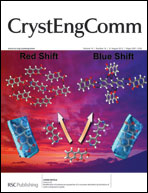N-Heterocyclic carbene silver(i), palladium(ii) and mercury(ii) complexes: synthesis, structural studies and catalytic activity†
Abstract
The bis-benzimidazolium salts, 1,2-bis[2-(N-R-benzimidazolemethyl)phenoxy]ethane chloride (L1H2: R = Et, L2H2: R = nBu), 1,3-bis[2-(N-R-benzimidazolemethyl)phenoxy]propane chloride (L3H2: R = nPr, L4H2: R = nBu) and bis[N-R-benzimidazolemethyl]mesitylene 2X (L5H2: R = nBu, X = I; L6H2: R = PyCH2, X = Br and L7H2: R = PhCH2, X = Br), as well as their eight NHC silver(I), palladium(II) and mercury(II) complexes, [(L1Ag)2Ag2Cl4] (1), [L1(PdCl2CH3CN)2] (2), [(L2Ag)2AgCl2][AgCl2] (3), [(L3Ag2Cl2)n] (4), [(L4Ag2Cl2)n] (5), [L5HgI][HgI4]0.5 (6), [L6Hg][HgBr4] (7) and [L7Ag][(NO3)0.76Br0.24] (8) have been prepared and characterized. The complexes 1–8 adopt four different structures: (1) with bis-macrometallocycles connected via a Ag2Cl4 unit for 1 and via a AgCl2 unit for 3, (2) an open structure formed via one


 Please wait while we load your content...
Please wait while we load your content...